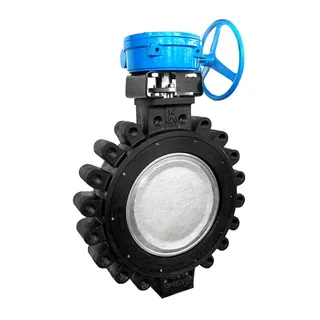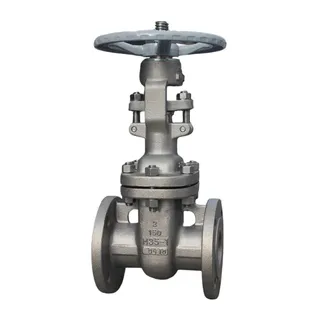In industrial production, valves are key components for controlling fluid flow. Among them, diaphragm valves are widely used across various fields due to their unique structure and performance. However, faced with numerous types of diaphragm valves, how do you choose the right model? This article provides a detailed diaphragm valve selection guide to help you find the most suitable diaphragm valve among many options.
A diaphragm valve is a special type of shut-off valve whose opening and closing element is a diaphragm made of soft material. The diaphragm separates the valve body cavity from the bonnet cavity and the driving parts, controlling fluid flow through its up-and-down movement. This structure allows diaphragm valves to perform excellently when handling corrosive, viscous, or particulate-containing media, while avoiding the packing leakage problems common in traditional valves. The main types are as follows:
The weir-type diaphragm valve, also known as a saddle-type diaphragm valve, is the most widely used type. The valve body contains a ridge-shaped weir. The diaphragm contacts the valve plug, and the plug drives the diaphragm to contact the weir to achieve fluid shutoff. This design ensures good sealing performance when closed, has a short stroke, and requires low diaphragm deflection, reducing diaphragm wear. Additionally, its simple and reliable structure, good wear resistance, and lack of dead zones that trap media make it widely used in many industrial applications. However, the disadvantage is that the ridge inside the flow path increases flow resistance.
The straight-through diaphragm valve has a straight tubular body. When fully open, the medium flows directly with almost no resistance. This design allows the valve to excel in low flow resistance, good shutoff, and flow capacity, while also offering strong corrosion resistance and accommodating particulate media. Its drawback is that when closing, the diaphragm requires a longer stroke and higher flexibility, which may affect the diaphragm's service life.
The inlet and outlet of the angle-type diaphragm valve are at a 90-degree angle, and the corner inside the valve body functions like a weir. This design allows the valve to change the flow direction of the medium by 90 degrees, making it suitable for applications requiring a change in flow direction. However, its disadvantages include higher pressure loss and larger installation space requirements, which limits its application to some extent.
The dull-bore diaphragm valve combines the features of a full-bore globe valve and a diaphragm valve. The valve seat and plug seal normally, and a diaphragm at the top of the plug provides mid-flange and packing sealing, while separating the valve body and bonnet so that the bonnet does not contact the medium. This design gives the valve high load capacity and sealing performance, linear flow characteristics, good flow capacity, and low flow resistance. However, the structure is relatively complex, the cost is higher, and special operating space for the handwheel must be considered during installation.
A pneumatic diaphragm valve uses compressed air as power, with a cylinder driving the diaphragm up and down to control fluid flow. Its flow characteristics describe the relationship between relative flow through the valve and displacement (relative valve opening). Ideal flow characteristics include linear, equal-percentage (logarithmic), parabolic, and quick-opening types. In practice, linear, equal-percentage, and quick-opening types are commonly used. Parabolic flow characteristics lie between linear and equal-percentage and are usually replaced by equal-percentage. Quick-opening characteristics are mainly used for two-position regulation and programmed control. Therefore, choosing pneumatic diaphragm valve characteristics primarily involves selecting between linear and equal-percentage flow characteristics.
After understanding the main types and characteristics of diaphragm valves, it is essential to explore the key factors in valve selection. These factors directly affect the performance and service life of the diaphragm valve, and must be carefully considered during selection.
Fluid characteristics are the primary consideration when selecting a diaphragm valve. Different fluids have varying physical and chemical properties, which directly influence valve selection.
Corrosiveness: If the fluid is corrosive, material selection becomes particularly important. For example: PTFE-lined diaphragm valves have excellent corrosion resistance, suitable for strong acids, strong alkalis, and other corrosive media. Rubber-lined diaphragm valves are suitable for mildly corrosive media. The lining material should be selected according to the level of corrosiveness to ensure valve service life and reliability.
Abrasiveness: When the fluid contains high concentrations of abrasive substances, the contact surfaces between the plug and seat experience significant friction each time the valve closes. For such abrasive media, diaphragm valves with strong wear resistance should be chosen. For example, weir-type diaphragm valves are suitable due to their simple and durable structure. Additionally, the valve flow path should be smooth, and internal materials sufficiently hard to minimize wear.
Temperature and Pressure: Fluid temperature and pressure are important factors in valve selection. If the fluid has high temperature and pressure and significant fluctuations, valves made from materials that tolerate such changes should be selected. For example, metal diaphragm valves often use a Y-shaped channel design for low-pressure-drop flow capacity, and a separated fluid and pressure chamber design allows perfect shutoff without spring assistance, making them suitable for high-temperature, high-pressure applications.
Flow characteristics describe the relationship between relative flow through the valve and displacement (relative valve opening). Selecting the appropriate flow characteristic is critical for ensuring system regulation performance.
Linear Flow: Linear flow means the relative valve opening is proportional to the relative flow. This characteristic is suitable for situations with small load changes and narrow regulation ranges. For example, in simple water treatment systems with limited flow variation, linear flow diaphragm valves can meet requirements.
Equal-Percentage Flow: Equal-percentage flow means that a change in valve opening results in a relative flow change proportional to the current flow. This is suitable for systems with large load variations and wide regulation ranges. For example, in chemical production, when precise flow adjustment is required, equal-percentage diaphragm valves are more appropriate.
Quick-Opening Flow: Quick-opening flow means the flow increases rapidly at small valve openings and changes more slowly at larger openings. This is mainly used for two-position regulation and programmed control. For example, in automatic control systems requiring fast opening or closing, quick-opening diaphragm valves can meet the requirements.
In addition to fluid and flow characteristics, other factors also need consideration:
Flashing and Cavitation: During valve operation, flashing and cavitation affect flow coefficient calculations, generate vibration and noise, and significantly reduce valve service life. When selecting diaphragm valves, choose designs that prevent flashing and cavitation. Some valves with specially designed plugs and seats can effectively reduce these phenomena.
Installation Space: Installation space must also be considered. For example, angle-type diaphragm valves require larger installation space due to their design, making them unsuitable in space-limited systems. Straight-through diaphragm valves are smaller and more suitable for compact pipelines.
Cost: Cost is an important factor. Different diaphragm valve types and materials vary significantly in price. For example, plastic diaphragm valves are cheaper due to lower material costs and are suitable for cost-sensitive applications. Metal diaphragm valves are more expensive due to material and manufacturing requirements and are suitable for applications demanding high performance.
After understanding the key factors, the specific steps for selection are:
Determine Fluid Characteristics: Identify the fluid's physical and chemical properties, including corrosiveness, abrasiveness, temperature, and pressure, and choose the appropriate valve type and material accordingly.
Determine Flow Characteristics: Choose suitable flow characteristics based on system regulation requirements. Linear flow is suitable for small load variations, equal-percentage for larger variations, and quick-opening for rapid on/off control.
Consider Other Factors: Evaluate flashing and cavitation, installation space, cost, and other factors to further narrow down suitable options.
Determine Valve Model: Finally, select the specific diaphragm valve model, considering diameter, pressure rating, connection type, and other parameters to ensure system requirements are met.
As a special type of shut-off valve, diaphragm valves have unique structures and performance, widely used across various industries. Selecting the right diaphragm valve requires comprehensive consideration of fluid characteristics, flow characteristics, flashing and cavitation, installation space, cost, and other factors. Proper selection ensures optimal performance, reliability, and safety in the system. This diaphragm valve selection guide aims to help you find the most suitable valve model among numerous options.



